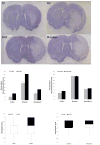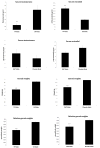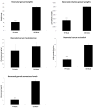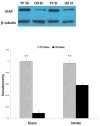Neonatal testosterone exposure protects adult male rats from stroke - PubMed (original) (raw)
Neonatal testosterone exposure protects adult male rats from stroke
Rebecca W Persky et al. Neuroendocrinology. 2013.
Abstract
Background: Men have a higher stroke incidence compared to women until advanced age. The contribution of hormones to these sex differences has been extensively debated. In experimental stroke, estradiol is neuroprotective, whereas androgens are detrimental. However, prior studies have only examined the effects of acute treatment paradigms; therefore, the timing and mechanism by which ischemic sexual dimorphism arises are unknown.
Methods: The effects of exogenous neonatal androgen exposure on subsequent injury induced by middle cerebral artery occlusion in adulthood in male rats were examined. Rats were administered vehicle (oil), testosterone propionate (TP) or the non-aromatizable androgen dihydrotestosterone (DHT) for 5 days after birth. At 3 months of age, a focal stroke was induced.
Results: Testosterone-treated rats (but not DHT-treated animals) had decreased infarct volumes (20 vs. 33%, p < 0.05) as well as increased estradiol levels (39.4 vs. 18.6 pg/ml, p < 0.0001) compared to oil-treated animals. TP-injected males had increased testicular aromatase (P450arom) levels (3.6 vs. 0.2 ng/ml, p < 0.0001) compared to oil-treated males. The level of X-linked inhibitor of apoptosis, the primary endogenous inhibitor of caspase-induced apoptosis, was increased in TP-treated rats compared with the oil-treated males.
Conclusions: Neonatal exposure to exogenous testosterone upregulates testicular aromatase expression in male rats and leads to adult neuroprotection secondary to changes in serum estradiol levels and cell death proteins. This study suggests that early exposure to gonadal hormones can have dramatic effects on the response to adult cerebrovascular injury.
Copyright © 2012 S. Karger AG, Basel.
Figures
Figure 1
Stroke outcomes in adult rats exposed to neonatal TP or DHT treatment. (A) Cresyl violet stained coronal brain slices showing infarct (white) in TP or DHT treated rats. (B) Quantification of infarct in TP and oil injected rats (shown as a % of the contralateral structure) in the cortex, striatum, and hemisphere (n=15 for TP males, n=14 for oil males; *P<0.05 vs. oil group; **P<0.001 vs. oil group). (C) Quantification of infarct in DHT and placebo treated rats (shown as a % of the contralateral structure) in the cortex, striatum, and hemisphere; n=13 for placebo group, n=15 for DHT group. (D&E) Neurological deficit scores in TP (D) and DHT (E) treated groups. White and black boxes show the data within 25_–_50% and 50_–_75% respectively; error bars present the minimum or maximum value.
Figure 2
Serum testosterone and estradiol levels as well as gonadal weights were affected by neonatal testosterone and DHT injection in adult animals. (A) Serum testosterone levels were increased in Oil compared to TP-treated rats at time of sacrifice. (***P<0.0001vs. oil group, n=10/gp). (B) Serum estradiol levels were increased in TP compared with Oil-treated male rats at the time of stroke (***P<0.0001 vs. TP group, n=7/gp). Serum levels of testosterone (C) and estradiol (D) were not significantly different between DHT and placebo-pellet implanted rats at the time of sacrifice (DHT n=15, placebo n=13). (E) Gonadal weights were decreased in TP-injected males compared to oil controls (***P<0.0001 vs. oil group. n=15/TP group, n=14/oil group). (F) Adult gonad weights of DHT implanted male rats were decreased compared to placebo male rats (***P<0.0001 vs. placebo group, n=15/DHT group, n=13/placebo group) Relative gonad/body weights were decreased in (G) TP group compared to oil as well as (H) DHT group compared to placebo.
Figure 3
Increased testicular aromatase levels in TP injected rats at the time of stroke. (A) Aromatase levels measured by ELISA in gonads were dramatically increased in TP injected males compared to oil injected rats (***p<0.001 vs. TP group, n=6/gp). (B) No differences in aromatase (B) levels and (C) activity in the brain (cortex) between TP and oil treated rats at the time of stroke (n=4/gp).
Figure 4
Neonatal TP administration led to changes in serum hormone levels and gonadal aromatase levels in PND16 rats. TP males had significantly decreased gonad weights (A) as well as gonad/body weights (B) but no difference in testosterone levels (C) compared with vehicle treated animals. (D) TP treated males had decreased serum estradiol levels compared to oil controls at PND16. (E) Testicular aromatase levels in TP males were significantly decreased compared to oil treated males. (***P<0.001 vs. oil groups, n=11/gp).
Figure 5
XIAP levels were increased in adult males exposed to neonatal TP (A) Representative Western blots of XIAP protein in sham and stroke rats. B-tubulin served as loading control. (B) Quantification showed XIAP levels were increased in TP rats both with and without (sham) injury. The optical density was expressed as the ratio of XIAP bands to control bands (B-tubulin) (**P<0.05 vs. oil groups. Semi-quantitative analysis of densitometry was performed from four independent sets of data).
Similar articles
- Regulation of androgen receptor mRNA expression in hamster facial motoneurons: differential effects of non-aromatizable and aromatizable androgens.
Drengler SM, Handa RJ, Jones KJ. Drengler SM, et al. Brain Res Mol Brain Res. 1996 Sep 5;41(1-2):8-15. doi: 10.1016/0169-328x(96)00060-5. Brain Res Mol Brain Res. 1996. PMID: 8883929 - Synergistic induction of aromatase activity in the rat brain by estradiol and 5 alpha-dihydrotestosterone.
Roselli CE. Roselli CE. Neuroendocrinology. 1991 Jan;53(1):79-84. doi: 10.1159/000125701. Neuroendocrinology. 1991. PMID: 2046863 - Aromatized testosterone attenuates contextual generalization of fear in male rats.
Lynch JF 3rd, Vanderhoof T, Winiecki P, Latsko MS, Riccio DC, Jasnow AM. Lynch JF 3rd, et al. Horm Behav. 2016 Aug;84:127-35. doi: 10.1016/j.yhbeh.2016.06.007. Epub 2016 Jun 28. Horm Behav. 2016. PMID: 27368147 - Isoflurane preconditioning neuroprotection in experimental focal stroke is androgen-dependent in male mice.
Zhu W, Wang L, Zhang L, Palmateer JM, Libal NL, Hurn PD, Herson PS, Murphy SJ. Zhu W, et al. Neuroscience. 2010 Aug 25;169(2):758-69. doi: 10.1016/j.neuroscience.2010.05.038. Epub 2010 May 24. Neuroscience. 2010. PMID: 20580788 Free PMC article. - Regulation of aromatase gene expression in Leydig cells and germ cells.
Bourguiba S, Genissel C, Lambard S, Bouraïma H, Carreau S. Bourguiba S, et al. J Steroid Biochem Mol Biol. 2003 Sep;86(3-5):335-43. doi: 10.1016/s0960-0760(03)00343-1. J Steroid Biochem Mol Biol. 2003. PMID: 14623530 Review.
Cited by
- Evaluating Sex Steroid Hormone Neuroprotection in Spinal Cord Injury in Animal Models: Is It Promising in the Clinic?
Coyoy-Salgado A, Segura-Uribe J, Salgado-Ceballos H, Castillo-Mendieta T, Sánchez-Torres S, Freyermuth-Trujillo X, Orozco-Barrios C, Orozco-Suarez S, Feria-Romero I, Pinto-Almazán R, Moralí de la Brena G, Guerra-Araiza C. Coyoy-Salgado A, et al. Biomedicines. 2024 Jul 4;12(7):1478. doi: 10.3390/biomedicines12071478. Biomedicines. 2024. PMID: 39062051 Free PMC article. Review. - A protective role of genetically predicted sex hormone-binding globulin on stroke.
He Q, Wang W, Xiong Y, Tao C, Ma L, Han J, You C. He Q, et al. Heliyon. 2024 Mar 30;10(7):e28556. doi: 10.1016/j.heliyon.2024.e28556. eCollection 2024 Apr 15. Heliyon. 2024. PMID: 38596080 Free PMC article. - Research progress on the role of hormones in ischemic stroke.
Huang S, Liu L, Tang X, Xie S, Li X, Kang X, Zhu S. Huang S, et al. Front Immunol. 2022 Dec 7;13:1062977. doi: 10.3389/fimmu.2022.1062977. eCollection 2022. Front Immunol. 2022. PMID: 36569944 Free PMC article. Review. - Roles of Testosterone and Estradiol in Mediation of Acute Neuroendocrine and Electroencephalographic Effects of Sevoflurane During the Sensitive Period in Rats.
Li N, Xu N, Lin Y, Lei L, Ju LS, Morey TE, Gravenstein N, Zhang J, Martynyuk AE. Li N, et al. Front Endocrinol (Lausanne). 2020 Sep 30;11:545973. doi: 10.3389/fendo.2020.545973. eCollection 2020. Front Endocrinol (Lausanne). 2020. PMID: 33101193 Free PMC article. - Testosterone May Hold Therapeutic Promise for the Treatment of Ischemic Stroke in Aging: A Closer Look at Laboratory Findings.
Farajdokht F, Farhoudi M, Majdi A, Zamanlu M, Sadigh-Eteghad S, Vahedi S, Mahmoudi J. Farajdokht F, et al. Adv Pharm Bull. 2019 Feb;9(1):48-55. doi: 10.15171/apb.2019.006. Epub 2018 Feb 21. Adv Pharm Bull. 2019. PMID: 31011557 Free PMC article. Review.
References
- Appelros P, Stegmayr B, Terent A. Sex differences in stroke epidemiology: a systematic review. Stroke. 2009;40:1082–1090. - PubMed
- Normann S, de Veber G, Fobker M, et al. Role of endogenous testosterone concentration in pediatric stroke. Ann Neurol. 2009;66:754–758. - PubMed
Publication types
MeSH terms
Substances
LinkOut - more resources
Full Text Sources
Other Literature Sources
Medical




